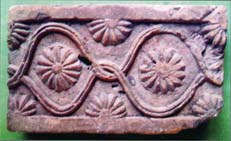Hariharer Garh
Hariharer Garh a place of archaeological interest in Harihar mouza, 3 kilometre northwest of the headquarter of Shailakupa upazila in Jhenaidah district. It is spread over nearly fifty raised mounds in Harihar and Nagpara villages. A few of the large mounds with protective canals around in lower land north of the garh are marked as the ruins of the Harihar palace. Even during the Pakistan period the mounds were covered with bushes. After liberation, the local people cleared the mounds and built houses for living. All over the garh area specimens of earthen potteries and artifacts used by inhabitants in the ancient time were found. While building houses some of the mounds revealed odd foundations of old buildings. These ruins showed the use of red burnt bricks as well as terracotta tablets having designs, as in the architecture of buildings during the period of the independent sultans of Bengal, of a variety of flowers and fruits, leaves and shrubs and geometric patterns. Quite a few terracotta finds from here have been preserved at the Bangladesh National Museum in Dhaka.

The raised mounds of Hariharer garh are known in different names; for instance, king’s vita, minister’s vita, Madhav Sanyasir vita, twin vita, banyan tree vita etc. While digging a pond in 1976 north of the king’s vita, a few steps of a flight of stairs leading down to the water level of a pond and innumerable bricks and terracotta pieces along with many earthen utensils, pieces of wood and animal bones were found. The corner of a room with a 5ft thick wall west of the same mound was discovered in course of digging work in 2007. At the northwest corner of the same wall, the lower part of an octagonal tower was also discovered.
As the characteristics of the wall and the terracotta pieces found here were similar to the finds at Hitampur shahi mosque located two kilometre south, it is presumed to be the ruins of a mosque built during the rule of the sultans. A large number of similar bricks and terracotta samples were found at the Madhav Sanyasy’s mound west of the king’s mound.
The exact history of Hariharer Garh is not known till now. According to archaeologist Pareshnath Bandopadhay, one of the 30 Buddhist viharas observed in the plains by Huen Sung in 639 AD was at Shailakupa.
In this region no archaeological site older than Hariharer Garh has been found. The Nag dynasty of the Soupayan clan coming from Kolanchanagar of Kanyakubja established their capital at Shailakupa and ruled the region. The dynasty originated with Shivroy Nag. His son king Korkot Nag ruled pargana Tarauzial. He and his brother Jatadhar Nag were contemporaries and rivals ofballalasen.Being annoyed with the caste system of Ballal Sen, Suklamvar Nag left Shailakupa in the thirteenth century and established his settlement at Nagpara southeast of Shailakupa and in due course built his capital on the bank of the small river. Raghunath Roy of this dynasty was the chief of the army of king pratapaditya of Jessore. He was killed in a war with Raja mansingh. Hariram, grandson of Raghunath Roy, built his canal-protected palace on a high and spacious mound in the lowland northwest of Nagpara. May be Hariharer Garh was named after him.
During the rule of the sultans of Gaur, the Hindu rulers of Tarauzial pargana were turned into tributary estates. At the beginning of the fifteenth century most people in the area became Muslims thanks to the efforts of darvesh Arab Shah, founder of the renowned six-domed mosque at Shailakupa. At the beginning of the sixteenth century, two more brick mosques were built at Hitampur and Harihar, not too far from Shailakupa. After Protapaditya's army chief Raghunath Roy was killed in a battle with Mansingh in 1603, the Mughal fouzdar Enayet Khan seized the estate of Raghunath. As the inheritors of the defeated ruler spread out to different places the palace at Harihar lost its glory. By the seventeenth century the smaller rivers of the area got silted up. It is presumed that because of an epidemic the Harihar palace became depopulated and slowly it fell into decay. [Mohammad Alamgir]
Bibliography Journal of the Asiatic Society of Bengal, Vol 70, Kolkata 1901; Bangladesh Asiatic Society Patrika, 9th year, December 1991; Sachitra Bangladesh, 11th year 17th issue, August 1990; Shatishchandra Mitra, Jessore-Khulnar Itihash, 2nd issue, 1966; Habiba Khatun, 'Ulugh Khan Jahan, Nibandhamala, Dhaka University, 5th volume, June 1989.
